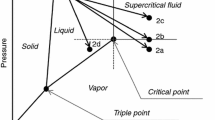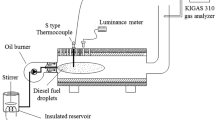Abstract
Auto-ignition characteristics of high-pressure diesel spray in the controllable active thermo-atmosphere (CATA) were studied with a high-speed camera video system. Multi-point autoignition phenomenon of diesel spray in the CATA was observed and the influence factors of the autoignition were analyzed. The stabilization mechanisms of the spray flame in different coflow temperatures were also discussed. The stabilization of the flames was controlled by different factors: autoignition phenomenon in low coflow temperature and flame spread in high coflow temperature. The test results also show that the autoignition delay depends strongly on the coflow temperature and has nonlinear relationship with the temperature. Autoignition delay decreases by almost 10 ms from 16.9 to 7.1 ms when the coflow temperature increases from 996 to 1048 K and only 4 ms from 1048 to 1101 K. The injection parameters in terms of nozzle diameter, injection pressure and pump speed, have some effects on autoignition delay while these effects depend on the coflow temperature. The significant effect lies in low coflow temperature. The injection parameters influence the autoignition delay because it can shorten the physical delay by improving the spray quality and enlarging the spray angle or penetration rate to improve mixture quality.
Similar content being viewed by others
References
Ryan T W, Callahan T J. Homogeneous charge compression ignition of diesel fuel. SAE Paper, 961160
Magnus C, Anders H, Bengt J. Demonstrating the multi fuel capability of a homogeneous charge compression ignition engine with variable compression ratio. SAE Paper, 1999-01-3679
Rudolf H S, Charles E R. Homogeneous charge compression ignition (HCCI): Benefits, compromises and future engine applications. SAE Paper, 1999-01-3682
Zhao F Q, Asmus T W, Assanis D N, et al. Homogeneous Charge Compression Ignition (HCCI) Engines: Key Research and Development Issues. Society of Automotive Engineer Inc, 2003
Su W H, Lin T J, Pei Y Q, et al. A new HCCI combustion system for diesel engines based on the technologies of multi-pulse fuel injection and the BUMP combustion chamber. Clean and High-efficiency Combustion in Engines (Vol A), Proceedings of the International Symposium. Tianjin, China, 2002, 105–118
Soon-Ik K, Masataka A, Hiroyuki H. Ignition delay of a diesel spray injected into a residual gas mixture. SAE Paper, 911841
Rosseel E, Sierens R. The physical and the chemical part of the ignition delay in diesel engines. SAE Paper, 961123
Edwards C F, Siebers D L, Hoskin D H. A study of the autoignition process of a diesel spray via high speed visualization. SAE Paper, 920108
Higgins B, Siebers D L. Measurement of the flame lift-off location on DI diesel sprays using OH chemiluminescence. SAE Paper, 2001-01-0918
Siebers D L, Higgins B. Flame lift-off on direct-injection diesel sprays under quiescent conditions. SAE Paper, 2001-01-0530
Dec J E. A conceptual model of DI diesel combustion based on laser-sheet imaging. SAE Paper, 970873
Crua C. Combustion processes in a diesel engine. Ph. D. Thesis. Brighton: University of Brighton, 2002
Wu Z J, Deng J, Li L G. Study on characteristics of controllable active thermo-atmosphere of a vitiated coflow combustor. Chin Sci Bull, 2005, 50(7): 704–707
Yu S. Fundamental study on preparation of the homogeneous charge by electrostatic charging. Master’s Thesis (in Chinese). Shanghai: Shanghai Jiao Tong University, 2005
Wu Z J, Deng J, Feng W, et al. Research method for auto-ignition of fuel jet in controllable active thermo-atmosphere. J Jilin Univ Eng Tech Ed (in Chinese), 2006, 36(1): 36–41
Lee J H, Lida N. Combustion of diesel spay injected into reacting atmosphere of propane-air homogeneous mixture. Intern J Eng Res, 2001, 2(1): 69–80
Aligrot C, Champoussin J C, Guerassi N, et al. A correlative model to predict autoignition delay of diesel fuels. SAE Paper, 970638
Cabra R. Trubulent jet flames into a vitiated coflow. Ph. D. Thesis. Berkeley: University of California, 2003. 182–195
Wu Z, Stamer S H, Bilger R W. Lift-off heights of turbulent H2/N2 jet flames in a vitiated coflow. Proceedings of the 2003 Australia Symposium on Combustion and the Eighth Australian Flame Days, Monash University, Australia, 2003
Kong S C, Han Z Y, Reitz R D. The development and application of a diesel ignition and combustion model for multidimensional engine simulation. SAE Paper, 950278
Wu Z, Masri A R, Bilger R B. An experimental investigation of the turbulence structure of a lifted H2/N2 jet flame in a vitiated co-flow. Flow Turbul Combust, 2006, 76(1): 61–81
Jiang D M. Combustion and Emission of Internal Combustion Engine (in Chinese). Xi’an: Xi’an Jiao Tong University Press, 2001. 441–444
Author information
Authors and Affiliations
Corresponding author
Additional information
Supported by the National Key Basic Research Program of China (Grant No. 2001CB 209201) and the National Natural Science Foundation of China (Grant No. 50546014)
About this article
Cite this article
Deng, J., Wu, Z., Huang, C. et al. Experimental study on multi-point autoignition characteristics and influence factors of diesel spray in a controllable active thermo-atmosphere. CHINESE SCI BULL 52, 277–283 (2007). https://doi.org/10.1007/s11434-007-0028-0
Received:
Accepted:
Issue Date:
DOI: https://doi.org/10.1007/s11434-007-0028-0




